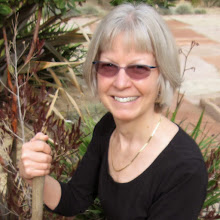It is a delicate case and an interesting journey, identifying the lesser of evils, choosing battles, deciding what is to be sustained, balancing environmental and human needs. Feel there are no pat answers. Believe it is for each of us to examine our own conscience, ways and means. My hope, though, is that many more will come to own their garden and their own destiny, resisting big corporate marketing of wolves in sheep’s clothing. One challenge is to trade in blowers in favor of rakes and brooms, and to shun chemicals in favor of beneficial bugs and organisms. Remember, the exercise is free – certainly cheaper than joining a gym!
In my own garden, I am “top dog.” If something is healthful for me, I opine it is healthful for the environment. I look to sustain myself first, other creatures next. And, I happen to be much more squeamish about chemical exposure than I am about encounters with four, six or eight-legged garden creatures! More on this tomorrow… Today, I am focused on my business.
As a designer of enduring gardens, I prefer to encourage lawn alternatives rather than alternative lawns. Nonetheless, deferring to clients' wishes, I try gentle persuasion. (It's that flies-honey-vinegar connection!) This is how I work to achieve sustainable balance in lawn-inclusive design under a variety of scenarios:
v Functional lawn: Client A insists on mown turf. Suggest it be minimized to that which serves a functional purpose, as defined by client. Leaves room for dialog about selecting a lower-impact turf grass, improving irrigation efficiency and using beneficial horticultural practices to enhance underlying soil structure and minimize polluting run-off. If I were to decline to design for client A, I expect they would find someone else, and that traditional practices would continue. My only accomplishment would be loss of a client.
v Alternative lawn/meadow: Client B appears to want mown turf for lack of other inspiration or budget. Again, draw out a discussion of functionality, and help them explore alternatives. For example, boulders in a meadow can lead to more creative, imaginative family fun than a small patch of mown lawn too small for a soccer game. Isn’t it beneficial to a young person’s health (with age-appropriate supervision) to pick up and get to know tiny garden creatures? There is a growing body of research pointing out that most kids today grow up nature-deprived. Conversely, I know of no health benefit from a nice tumble on a turf lawn, laced with chemical pesticides, herbicides and fertilizers the gardener spread, and which are waiting for the proper irrigation day to be watered in!
v Retain lawn in front, consistent with community plan; rear lawn replacement: Client C seeks lawn alternatives. Suggest reducing front lawn to minimum consistent with community guidelines*, while replacing species with lower-impact turf grass, etc., as noted in A, above. Also, if existing lawn is edged by hardscape, suggest a planted border, or at least permeable surface or containment/transition to avoid run-off to street, sidewalks and other impermeable surfaces. (Note: length, severity of drought may make front lawn replacement decision for us!) Employ the functional dialog to repurpose rear lawn area to client-desired function. Examples: (1) Children’s play equipment placed over surface of play bark – later this can become an edibles garden or a casual dining court once the play equipment is outgrown, depending on solar exposure and needs. Or, (2) Outdoor room for entertaining. Or, (3) Tapestry garden, featuring meandering paths through native and compatible planting, casual seating, and perhaps a few bits of sculpture or other focal objects.
* Hope to be invited to speak to local Homeowners’ Associations (HOAs) to help them find new, improved visions of enduring beauty in their planned, community landscapes, what I call “creating a new heritage in Southern California gardens.” Meanwhile, homeowners in such communities are reticent to go against the grain of lawn-based landscapes “dictated” by covenants, codes and restrictions (CC and Rs) even when such guidelines fly in the face of legally enforceable water restrictions.
Barbara, I appreciate your wisdom and insights. I hope you don’t mind my following on the lead you’ve taken on the subject of lawns, alternatives and sustainability, and connecting that here with my business focus and passion.
My knowledge of environmental concerns is growing, and I try to respond accordingly in my life and work. In addition to saving money, saving water reduces fossil fuel consumption and reduces pollution of natural waterways. Did you know, here in Southern California, pumping water from its source and/or to/from its treatment uses a great deal of non-renewable energy? I am attending classes in Sustainable Landscape for Professionals offered by the City of Santa Monica. In addition, I received water management training toward Certified Landscape Irrigation Auditor (CLIA.) My irrigation certification is pending qualified work experience. See begarden listed here by the City of Santa Monica as Sustainable Landscape Professional. I have a Certificate in Landscape Design from California State University, Northridge (CSUN.) My business website is begarden.com.




2 comments:
Janis, I do so appreciate your picking up this important subject. Love some of your ideas. It is important that it not be an "all-or-none" discussion. Everyone can move in the right direction and have an impact. Sounds like you are doing some really great work!
Barbara, thank you! Your support means so much to me. The work is beginning to come together.
Post a Comment